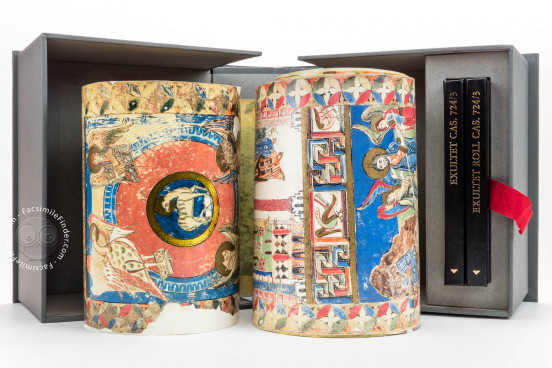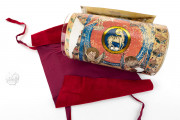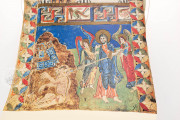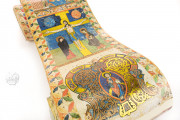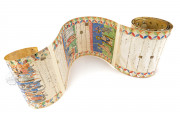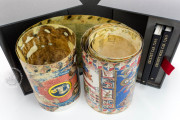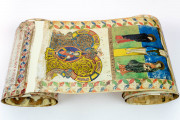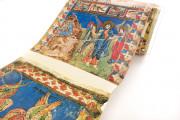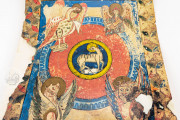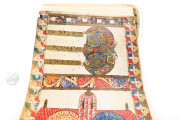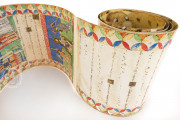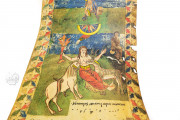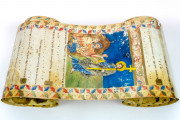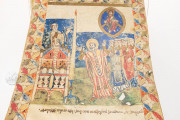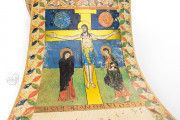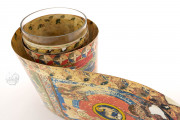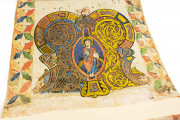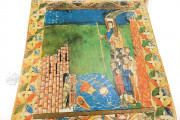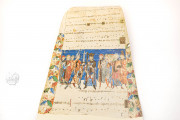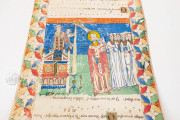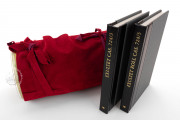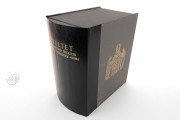Made either in Benevento or Monte Cassino, the twelfth-century Casanatense Exultet Roll is one of only a few illuminated Romanesque Exultet rolls to have survived. In its original state it would have been (approximately) an impressive 6.85 m in length, with remarkable illustrations throughout its length. The use of rolls dates back to antiquity and was never entirely replaced by the codex. In the Middle Ages this format continued to be used for a variety of texts, but the Exultet and the Benedictio Fontis are the only two liturgical texts to employ this form.
The "Exultet" is a ceremony dating back to around 400 and is performed on Easter Saturday. At midnight, the large Paschal candle is lit to symbolize the light brought to the world by Christ’s resurrection, which is then celebrated on Easter Sunday (miniature 5). The term derives from the first words of the opening chant: Exultet jam angelica turba caelorum ("Now let the angelic multitude of the heavens exult")*.
Miniatures in the rolls demonstrate how the Exultet roll was used to add drama to the event. During the rite, the celebrant stood at an ambo, or pulpit, facing the people. As the rite continued, the roll would be unfurled, rolling down in front of the ambo, towards the people.
Early rolls with only the text and neumes (musical notation) were initially used in this way, but a manuscript, made between 985–987 for the convent of St Peter at Benevento in southern Italy, Ms. Vat. Lat. 9820, began a tradition of illustrated Exultet rolls.
A manuscript at Bari, made in the second quarter of the eleventh century, was probably responsible for the inspired decision to invert the images to the text. The Bari roll, Archivio Capitolare, Exultet MS. 1, was arranged so that the text and music were oriented correctly for the celebrant, but as the roll unfurled the images would be in the correct orientation for the congregation to enjoy. The Casanatense Exultet roll successfully continued this tradition.
Blessing the Bees
The illustrated Exultet rolls appear to follow a tradition that adheres to a particular order and composition of the depictions, with only minor alterations and adaptions. Both the Bari Roll and the Casanatense Exultet relate to the earlier Ms. Vat. Lat. 9820, mentioned above. But the Casanatense Exultet Roll increases the width to 23.5 cm which necessarily increased the size of the depictions thereby allowing better visibility for the congregation.
The once magnificent roll has been separated into ten sheets bound by calfskin. An extensive palette of colors including gold is employed in the seventeen illustrations. They are in generally good condition, but those at the beginning of the roll show more evidence of wear and slight fire damage than those towards the center.
Two of the illustrations are large decorated initials, sheet 2, "E", and sheet 5, "V", covering an area the size of many of the depictions. They demonstrate the earlier Germanic style of complex interlacing but are not considered to be of the same quality.
Throughout the roll are repeated depictions of the archbishop, which scholars have thought to serve as a possible means of reinforcing ecclesiastical power (miniatures 1, 5, 9, 15). Attempts have also been made to establish the archbishop's identity by analyzing the miniatures in order to indicate a possible patron, but this has proved inconclusive. Some scholars also suggest that the figures are not intended to portray a particular person but are generic, indicating only which church officiates should take part.
Depictions include the Lamb of God, Christ and Mother Earth (Tellus), Angels and Seraphim, the Killing of Satan, and the Lighting of the Paschal Candle. Also included is a depiction of a number of bees around rectangular hives. A blessing is included to the bees who made the wax which formed the Paschal candle. Both Jerome (d. 420) and Augustine (d. 430) wrote poems similar to the "Exultet" both of whom probably included such blessings in their poems.
A Regular and Pleasing Form
The scroll is written in Beneventan minuscule, a script named after the region in southern Italy where it flourished. Possibly created as a reaction to the evolving Carolingian scripts, Beneventan minuscule was employed in the region from the late eighth century until the end of the thirteenth century, when it was slowly replaced by Gothic script.
Beneventan minuscule demonstrates regularity and precision in the construction of letter forms. The script is characterized by extensive use of ligatures, giving the text a particularly attractive appearance.
A Prominent Collector
Little is known about where the roll was made and about its patron. The manuscript formed part of the collection of rare and ancient books amassed by Cardinal Girolamo Casanate (1620–1700), a prominent member of the church. His collection of 20,000 items included Pontifical (for the ordination of priests) and Benedictional liturgical rolls bearing the seal of Landolfo I, archbishop of Benevento in the late ninth century, as well as the Casanatense Exultet Roll.
There is evidence that both Jean Mabillion (1632–1707), a French Benedictine monk, and Giovanni Ciampini (1633–1698), an ecclesiastical archaeologist, saw the Exultet Roll in the Cardinal’s library in Naples before it was brought to Rome to establish the Biblioteca Casanatense, founded in 1701.
* Latin translation courtesy of Dr James H. Pedersen.
We have 1 facsimile edition of the manuscript "Casanatense Exultet Roll": Exultet Casanatense facsimile edition, published by Priuli & Verlucca, editori, 1994
Request Info / Price
